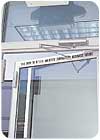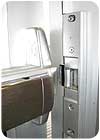

Electric door strikes are typically installed in the door jamb.
Electromagnetic locks consist of two pieces — a powerful frame-mounted electromagnet and a door-mounted armature. Both the lock and the reader are connected to the access control system, which temporarily cuts the power to the magnet when a valid credential is presented, enabling authorized individuals to enter a secured area through the door.
Installers also must provide a method of cutting power to the lock from inside the secured area so users can exit. This is accomplished by connecting a request-to-exit device, typically a button or passive infrared detector, which temporarily cuts power to the electromagnet.
Additionally, technicians should install a request-to-exit device that is not tied in to the system to guard against people becoming locked in if a lightning strike or other event causes the access control system to fail. To meet this need, installers typically put in pneumatic buttons, which latch and unlatch the door using an air pressure control. Although the pneumatic button could be used as the everyday request-to-exit mechanism, often security dealers prefer to reserve it for emergency use, as it will typically release the door for 15 to 30 seconds. In comparison, request-to-exit buttons that are controlled by the access system typically release the door for only about five seconds.

Request-to-exit buttons enable people to exit through doors secured by electromagnetic locks.
Cautions & Precautions
Mag locks work independently of the door’s existing lock hardware, which is left unlocked. That means the door could become unsecured in the event of an extended power failure. To minimize this risk, installers should ensure ample backup power, advises Dick Harpster, president of Central Security Systems of Southern Pines, N.C. Additionally, he advises leaving existing lock hardware in place as a backup and explaining to business owners that they will need to physically lock the traditional lock in the event that the system becomes inoperative.Because of this, however, Central Security and some other companies try to minimize their use of mag locks. “Unless it’s really demanded, we don’t use electromagnetic locks,” notes John Spooner, vice president of Alarm Detection Systems, an Aurora, Ill.-based security company. “We usually do magnetic door strikes because they provide free access from the inside out and more control from the outside in.”

Some authorities require the use of pushbars to enable fast exit through doors secured by access control systems.
An important issue with electric door strikes, however, is that they require installers to cut a hole in the door. That requires special tools and practice and, if not done properly, the door could require replacing. “If you mess up, you’re usually talking a major expense,” Harpster notes.
For that reason, Central Security and other alarm companies enlist locksmiths who have the proper tools and training to install the electric strike hardware — and some companies see that as a significant drawback. “In all cases, we prefer electromagnetic locks because you don’t get the locksmith involved,” notes Ziad Ghossaini, director of technical services for Devcon Security Services of Hollywood, Fla.
Other companies, however, find indirect benefits from their work with locksmiths. “If you’re a smaller company, the best thing is to develop a relationship with a locksmith,” Harpster says. “Keep in mind that he’s in a position to refer business to you.”

Electric door strikes work in combination with existing lock hardware.
Whether out of preference or necessity, once the decision has been made to use an electromagnetic lock in an installation, the next issue to be resolved is which model to use. Manufacturers offer a wide variety of models to suit different types of doors, and a good distributor can help in selecting the right one.
Mag locks also have ratings to indicate how many pounds of force they can withstand. As an example, Vince Lupe, director of product management and planning for Diebold Global Security, says, “If I had a door with a server farm behind it, I’d want to use a 1,200-pound lock. But if you had just a break room, you may just want to have the lightest, cheapest lock, just enough to keep the door shut.”

Mag locks consist of a frame-mounted electromagnet and a door-mounted armature.
Check Your Power Supply
The power supply is another important consideration. “Make sure you have a filtered regulated power supply that gives full DC clear power,” advises Jimmy Billings, operations manager for Blue Ridge Security Systems of Henderson, S.C. “If it has ripples, it may not give the right holding force.”To install a mag lock, technicians must drill holes to mount the armature and the electromagnet and typically an additional hole in the frame that will act as a passageway for the wiring. Although the mag lock pieces can be used to mark the drill holes, some technicians find it helpful to use the jigs, or templates, that come with some manufacturers’ locks. Spooner of Alarm Detection Systems prefers that option because, as he explains, “In some cases, you can use the device, but sometimes it’s awkward because you can’t get it flush to the door.”
Correct placement of the template is also important. “If it’s too close to the hinge side, someone could start pulling on the door and maybe damage it,” cautions Brad Cary, systems sales manager for St. Louis-based security company Tech Electronics.
When mounting the magnet and armature, technicians should pay close attention to the binding, or tightness of the seal between the two parts. “Make sure the armature has a little play; then when it closes, it can bind correctly,” Billings advises. “You have to have it to where you can move it with your hands a bit or it won’t bind together.”
If there is too much play, however, the door may become drafty. To avoid problems, technicians should pay close attention to the manufacturer’s recommendations on binding.
Another consideration about electromagnetic locks comes into play when a customer has a fire alarm system. If so, installers should connect the mag lock to the fire system so that, in the event of a fire, the door will automatically release.

Mag locks come in a wide range of models, including this one designed for use with a wood frame.
Testing and service
After each mag lock in a system is completed, technicians should perform some simple tests on each lock.Arlington Security technicians, for example, pull on each door to make sure it holds, Kretz says.
When all of the doors have been completed, the full system should then be tested for proper operation with the access control system. “We power up the unit, program access levels into the system and then verify that the codes work,” Devcon Security Services’ Ghossaini says. “In commercial applications, we test the fire alarm and trip it to make sure the door releases. We also test it in a power failure mode.”
After they have been installed for a period of time, electromagnetic locks sometimes run into service issues, as environmental changes can impact the system. To diagnose a problem, technicians should first check power to the door using a voltmeter to determine if the access control system is functioning correctly. If so, then the problem is a mechanical one.
“Sometimes moisture and corrosion set in and the door starts sticking,” Harpster explains. “Or sometimes in new buildings, the door is shifted and we have to get the builder back to correct it.” In older buildings, Harpster says, Central Security calls a locksmith to correct mechanical problems. Other companies call on a locksmith only when they are unable to fix the problem themselves. The solution typically is to adjust the position of the magnet on the doorframe.
Whether a company uses them regularly or only when necessary, understanding electromagnetic locks is critical for any security company that installs access control systems.